| About 1,000 Rhododendron species exist, mainly in the Sino-Himalayan region. Some are deciduous but most are evergreen, varying from tiny shrubs to towering trees. The huge number of species and (even more) hybrids, and their extraordinary leaf and floral diversity, makes them irresistible to gardeners. Seattle has one native species, that also is the official State Flower of Washington: Rhododendron macrophyllum. I shall write about it here. |
| (But first, must correct what I just wrote about Seattle having only one native Rhododendron. Because the aromatic Labrador Tea shrub of our boggy wetlands that since 1771 has been called Ledum grœnlandicum, has been, since 1990, considered best regarded as a Rhododendron. ) |
| Common names for Rhododendron macrophyllum include: Pacific Rhododendron, California Rose-Bay or Rhododendron, Coast or West Coast Rhododendron. And I call it Native Rhododendron. In general, Rhododendron is called Rhodie (Rhody) or Rhodo for short. The clumsy generic name Rhododendron dating from 1754 is from the Greek rhodon, rose, and dendron, tree. The 1834 name Rhododendron macrophyllum alludes to the fact that at that time, the namer believed it had exceptionally large leaves. In fact, within the context of the entire genus, its leaves are not notably large. Many other species bear larger leaves --some exceeding 3 feet long. |
| Its native range extends from SW British Columbia into California, along the coast. In western Washington, it favors drier areas than Seattle, so is more common in the eastern Olympic Peninsula and the Kitsap Peninsula. A few wild specimens did and do grow on Bainbridge Island, Vashon, and in Seattle. Virtually or literally all of the few wild plants in Seattle were either transplanted to gardens, or were destroyed by development. The largest specimens that I know in the city, were planted in a ravine in Frink Park. They are infected with a Exobasidium fungus that causes them to have unsightly witches' brooms. For a link to a website that has a map of the species' native range, click here. |
| Rhododendron macrophyllum foliage is not exciting. On many species of Rhododendron, the leaves beg to be caressed because of their wonderful texture; and some bear aromatic buds. Rhododendron macrophyllum leaves measure as large as 8 inches by 3 inches, are hairless, darker green on top, and paler green beneath. In severe cold or dryness they curl inwards. |
| Lovely pink floral beauty is why people prize this shrub. From April into May (later in mountains), depending on the locale and the year, it bears attractive (nearly white) pale pink to deep rose blossoms. When there is an especially good year, densely populated native stands are visited by delighted sightseers, photographers and hikers. That is why it was chosen as Washington's State Flower. |
| It has been reported as tall as 40 feet in general. In 1976, one in California measured 33 feet tall, its trunk 1 foot 8 inches circumference. In 2007, an Oregon tree was 24 feet tall, its trunk 3 feet 1 inch circumference. But Frank Callahan informed me that in the early 1960s, he saw a log of one on a logging truck near Brookings, Oregon, that measured 3 feet thick at the butt end, and 1.5 feet thick at the other end, which was 16 feet away. |
| A former navy fighter plane pilot told me that when he flew over the extensive stands on the Kitsap Peninsula, he was certain some straggly specimens were taller than 40 feet. Because of security concerns, unauthorized personnel cannot visit some of the stands near the submarine base. |
| The most remarkable thing about this species, compared to most Rhododendron species, is that it is adapted to a dry-summer climate. Most rhodies are notably thirsty during the period in which they make their annual growth. So, for a xeriscape or low-water garden, Rhododendron macrophyllum is ideal. If irrigated, or planted in a damp site, varied fungal diseases are more apt to disfigure it. |
| Likely due to a "native plant" wholesale nursery's mistake, in and near Seattle, an imposter species is now and then sold and planted as this species --but is really from SE Europe and SW Asia: Rhododendron ponticum, the Lavender, Pontus or Pontic Rhododendron. It is common as a rootstock to graft upon; it rarely makes seedlings in Seattle, though is a major weed in some parts of the British Isles and Ireland. Below I show a photo of one. It differs from Rhododendron macrophyllum in having slender, dark green, often glossy leaves; being denser; and in having tighter clusters of darker flowers opening later. Due to its floral color, it sometimes is nicknamed the Lavender or Purple Rhody. |
| Rhododendron macrophyllum can grow in sun or shade. But in full sun it may be scorched and malcontent. There is one (see photos below) on a southwest-facing steep bank where I live, that gets no direct sun due to the house. Other native species near it include Salal (Gaultheria Shallon), Mock Orange (Philadelphus Lewisii), Oregon Grape (Mahonia Aquifolium and M. nervosa), Hazel (Corylus cornuta var. californica), and Dogwood (Cornus Nuttallii). |
| Many Rhododendron are poisonous to people --even too much Rhododendron honey can cause sickness. Rhododendron macrophyllum specifically is known to be poisonous to sheep. (Too bad it is not Rhododendron arboreum --a Himalayan species with red, edible flowers.) |
| Rhododendron macrophyllum is related closely to two species of eastern North America: R. maximum and R. catawbiense. |
| At least six Rhododendron macrophyllum cultivars have been named: 'Albion Ridge', 'Album', 'Brookings Deep Pink', 'Iron Mountain White #1', 'Seven Devils', and 'Vulcan Lake White'. |
It has been used a bit in hybridizing --as early as 1918, and eight such offspring are:
|
| 'Albert Close' (R. maximum × R. macrophyllum) |
| 'Grandma Barbara' (R. macrophyllum × ?) |
| 'Jackie Ann' (R. macrophyllum × ?) |
| 'Oregon Queen' (R. macrophyllum × R occidentale) |
| 'Sparkling Burgundy' (R. 'Purple Splendour' × R. macrophyllum 'Seven Devils') |
| 'Walluski Chief' (R. macrophyllum × R. Griersonianum) |
| R. macrophyllum × R. × agastum |
R. arboreum ssp. arboreum × R. macrophyllum
Back |

Rhododendron macrophyllum at my house, May 14 2004 photo by ALJ
|
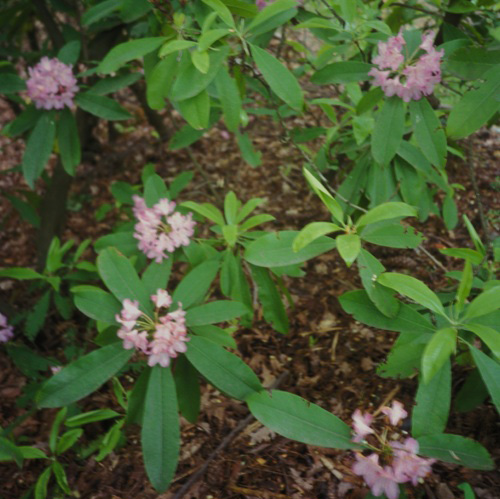
Rhododendron macrophyllum at Washington Park Arboretum, May 25 1999 photo by ALJ
|
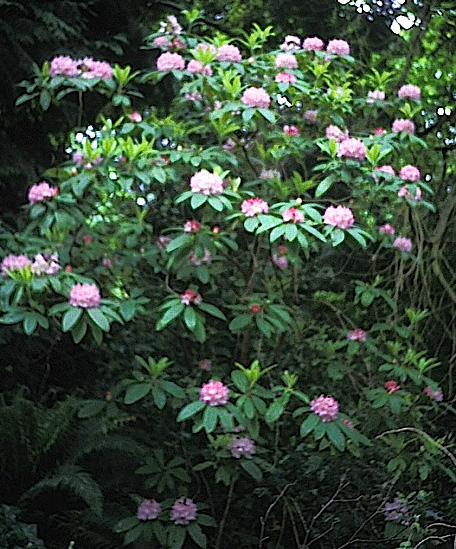
Rhododendron macrophyllum at Clarke Beach Park, May 12 1998 photo by ALJ
|
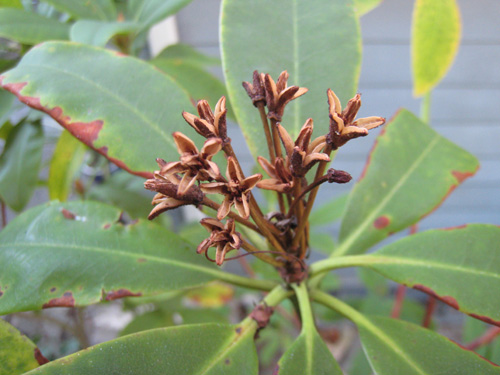
Rhododendron macrophyllum seedpods, Oct. 17 2010 photo by ALJ
|
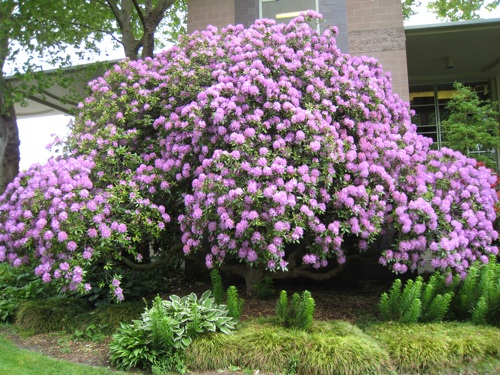
Rhododendron ponticum, June 11 2008 photo by ALJ
|
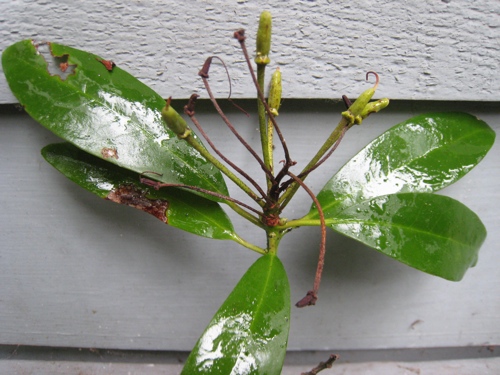
Rhododendron ponticum seedpods Oct 26 2010 photo by ALJ
|

